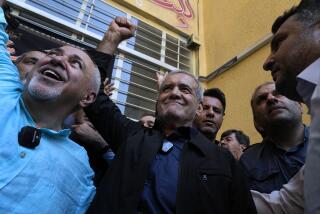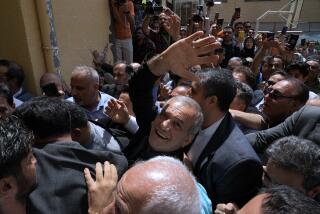Iran’s New President Faces Major Economic Headache : Nation Lacks Resources to Rebuild After Iraqi War but Islam Frowns on Foreign Loans
- Share via
NICOSIA, Cyprus — Battered and bled by a grinding, eight-year war and constricted by the politics of religion, the economy of Iran presents Hashemi Rafsanjani with the toughest challenge of his new presidency.
The day after his Aug. 3 inauguration, Rafsanjani announced in a sermon in Tehran that he has a crash program with long- and short-term policies to revive limping factories, restore the petroleum industry, provide work for the jobless and put goods on the empty shelves.
“Within one year,” the 55-year-old clergyman-politician declared, the government “will prepare the necessary facilities for all of our existing factories to reach their full capacities.” They are currently operating at 20% to 30% of capacity.
Immediately, he said, the government will move “to improve the lives of the deprived people . . . for whom it is not fair to live another decade in austerity.” And, he added confidently: “I am sure the Majlis (Iran’s Parliament) will cooperate in this matter.”
Foreign Loans Required
There’s the rub. Before and after his July 28 election, Rafsanjani dropped loud hints that he would turn to the West for help. Iran’s slogan of independence is “neither East nor West,” but even before his election the pragmatic president had gone East, nailing down a series of development and military deals in Moscow.
A similar approach to the West will require foreign loans. Economic analysts figure that Iran will need at least $100 billion above current revenue to meet its development goals over the next 10 years. And borrowing abroad is repugnant under the Islamic code of Iran.
The Majlis, with a strong contingent of strict fundamentalists, will test Rafsanjani’s persuasive powers when it takes up the government’s five-year economic plan in the weeks ahead. Interior Minister Ali Akbar Mohtashemi bluntly laid out the hard-line, xenophobic view in an interview with the Tehran Times: “Iranians would rather observe a fast than surrender to creditors who want to impose terms and conditions on us.”
So far, under a decade of revolutionary Islamic rule, Mohtashemi’s attitude has prevailed: By the government’s unusual method of calculating what it owes, Iran has long-term foreign debts of little more than $500 million.
Soaring Inflation
So what is the problem in a developing country that ranks among the world’s top oil producers, carries a foreign debt that looks like pocket change compared to Brazil’s and Mexico’s and has a private sector with capital to invest if it had the confidence? Plenty.
* Inflation is soaring. The government puts it as 23%, but outside analysts estimate that it is double that. Shopkeepers have been ordered to fix and tag the prices of the few goods they have for sale, but higher offers bring items out from under the counter. Civil servants have not had a raise in 10 years.
* The currency is out of whack. Recent visitors to Tehran say black market dealers were giving 1,400 rials to $1, while the official dollar rate was 73 rials. Coupon books for subsidized goods for the poor, once issued monthly, have been distributed bimonthly at best.
* Petroleum facilities were badly damaged by Iraqi bombing in the war that ended last August, crippling an industry already punished by the oil price collapse of 1985. Overall, war damage to the Iranian economy has been estimated at $100 billion.
* Unemployment is 15% to 20% by unofficial estimates, not bad considering the devastation of the war. But, as is the case in other developing countries, population and urbanization bombs are ticking in Iran. Economics Minister Javad Iravani recently disclosed that the population growth rate is 3.9%, compared to 2.4% before the 1979 revolution that overthrew the Shah.
* Power plants were heavily hit in the fighting, and blackouts are common in Tehran.
Now, after the long and enervating war and the tense political struggle for succession to the late Ayatollah Ruhollah Khomeini, the Iranians are looking to Rafsanjani, who won 94% of the presidential vote against a token opposition candidate, to fulfill his campaign promises of economic progress.
“The war’s over. Public expectations are rising,” Vahe Petrossian, who covers Iran for the respected Middle East Economic Digest, explained in an interview in his London offices. “He (Rafsanjani) has to initiate policy. He has to show some authority.”
Loans From Soviets
The question of foreign loans will top the docket. Iravani, the economics minister, told the Tehran monthly journal Iqtesad that Iran should rely as much as possible on domestic capital but added: “We must deal realistically with borrowing from foreign sources far from political ballyhoo.” He estimated Iran’s present foreign reserves at $6 billion to $7 billion, including gold.
In May, Soviet Railways Minister Nikolai Konarev was in Tehran to discuss a Soviet offer of $1.9 billion in credits to finance joint industrial projects. The friendly interest rate, he said, would be 1.5%. Iravani said the total economic package approved by Rafsanjani in Moscow involved a $2-billion Iranian debt to the Soviets, which will be paid back by shipments of natural gas.
The Economist Intelligence Unit, a London-based publication, estimates that the current Iranian budget totals about $4 billion in foreign “borrowings,” including $2.4 billion in credits for supplies tied to specific industrial projects and the rest in short-term financing. The credits, never termed loans, have been arranged with European banks and are drawn against future oil deliveries. The political disguise of the term leaves the official foreign debt at the $500 million mark.
Restoring Oil Production
Deals pinned down by the Iranians with China and other countries involve barter for Iranian petroleum products, the bulwark of an export economy that otherwise leans on a high-priced assortment of Oriental carpets, pistachio nuts and caviar. Non-oil exports declined 11% in the year ending last March, totaling less than $1 billion, according to published reports.
Direct trade with the United States appears to be politically out of the picture for now, although Petrossian said some British-based American companies are interested in industrial projects in Iran.
Petroleum revenue for this year is expected to reach $11 billion, with Iranian production expected to fill the quota set by the Organization of Petroleum Exporting Countries. Restoration of oil facilities was the top priority of industrial planners, who put 6,000 workers to the task of repairing the war-wrecked refinery at Abadan and got the first export shipment out in early May.
With $11 billion or $12 billion in annual foreign exchange revenue, plus some visible or invisible borrowing, Rafsanjani will be hard pressed to stretch his resources to cover the need.
Heino Kopietz, an Iran specialist with the International Institute of Strategic Studies in London, said in an interview that the government will spend $4 billion to $5 billion this year--and for years ahead--to rebuild its military, which remains at full personnel strength but is under-equipped in the face of a war halted only by a truce. “The military cannot stand naked,” Kopietz remarked, “and they see the Iraqis loading up again.”
With the demands for rearmament, rebuilding industry and importation of required raw materials, there is little or nothing left to alleviate the immediate needs of the Iranian people. They may have to wait for the engine of the economy to get going again. Such politically explosive questions as land redistribution will probably be put in abeyance.
‘What Is Practicable’
Central Bank Governor Majid Qassemi told a recent Tehran news conference that the government would spend $4.8 billion during the current year on imported food and consumer goods but did not disclose how that target could be achieved in the face of industrial and military demands. Rafsanjani has been more cautious.
“I have a series of hopes for the future of the country that may or may not square with the potentials at hand,” Iran’s official news agency quoted the new president as saying last month. “I will try to realize what is practicable.”
The Tehran Times, a Rafsanjani supporter, advised in an editorial: “We would be doing Rafsanjani a disservice if we do not temper with wise moderation a too-exaggerated hope in what he can accomplish by an excessive adulation of him. . . . To overreach ourselves in expecting miracles--which of course have their proper place in the scheme of things--would be to hurt him.”
More to Read
Sign up for Essential California
The most important California stories and recommendations in your inbox every morning.
You may occasionally receive promotional content from the Los Angeles Times.













